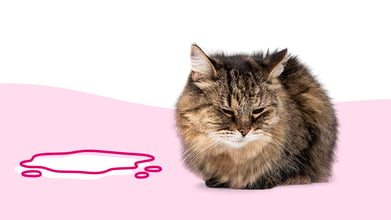Understanding and Preventing Urine Marking in Cats

Cats are territorial creatures that use various methods to communicate and mark their territory. One common behavior is urine marking, where cats release small amounts of urine to establish territory or react to stress, environmental changes, and some medical conditions.
Urine marking must be discussed with a veterinarian who can distinguish between behavioral and medical reasons to ensure your cat is healthy and well-adjusted.
🔑 Key Takeaways:
-
Urine marking can be caused by territorial instincts, stress, medical conditions, or a combination of factors.
-
Rule out any underlying health issues that may be contributing to urine marking.
-
Provide a clean and comfortable environment with enough litter boxes, scratching posts, and hiding places.
-
If necessary, consult with a veterinarian or feline behaviorist for guidance on behavioral modification techniques.
What is Cat Urine Marking and Spraying?
Urine marking and spraying in cats is the intentional release of small amounts of urine, usually on vertical services. Typically, a cat will back up to a surface, raise their tail, and spray urine. This can occur both indoors and outdoors. While it's most commonly seen in unneutered male cats, it can also occur in females and neutered cats.

Why Do Cats Urine Mark?
Cats may engage in urine marking due to behavioral or medical reasons. Behaviorally, it can be triggered by territorial instincts, stress, or environmental changes. Medical causes include urinary tract infections, bladder stones, and kidney disease.
Male cats are particularly susceptible to urethral blockage, a life-threatening emergency requiring immediate veterinary attention.
Let's break down each of the above-mentioned reasons for urine marking:
Behavioral Reasons
-
Establishing Territory: by marking their territory with the scent of their urine, cats can signal their presence to other cats and establish boundaries.
-
Stress and Anxiety: environmental changes, such as a new pet, guest, or furniture, can cause stress and lead to urine marking.
-
Territorial Disputes & Competition for Resources: a change in litter boxes, food, or changes in their environment, such as:
-
A new addition of a pet or family member, a household guest, or even a new piece of furniture could trigger the urine-marking behavior.
-
Not enough litter boxes in a household may trigger some cats to go outside the box.
-
Even a piece of luggage that is being packed or unpacked after a trip may trigger a cat to claim that territory.
-
Medical Reasons for Feline Urine Marking
Medical reasons for urine marking or accidents can quickly escalate to more severe health issues. Conditions that could cause urine marking include:
-
Bladder Stones
-
Diabetes Mellitus
-
Hyperthyroidism
-
Arthritis
-
Urethral blockage - This condition occurs when the urethra, a tube that carries urine from the bladder to outside the body, becomes blocked by debris from within the bladder, such as urinary crystals or mucus plugs. These plugs prevent urination, which quickly leads to life-threatening complications.
⚠️ Note: Cats that are blocked will often strain to urinate (often in a normal urinary position) with little to no urine production, attempt to go frequently (in and out of the box), vocalize, and become painful. Anorexia, lethargy, vomiting & diarrhea can also develop. Kidney failure, cardiovascular collapse, and severe pain result if left untreated.
How to Stop Urine Marking Behavior
Understanding the underlying cause is essential to effectively addressing urine marking. Here are some steps you can take to prevent this frustrating behavior:
-
Veterinary Consultation: consult with a veterinarian to rule out any medical conditions.
-
Spaying or Neutering: this can help reduce territorial instincts and hormonal influences.
-
Address Stress and Anxiety: identify potential stressors in your cat's environment.
-
Environmental Enrichment: provide scratching posts, toys, and plenty of hiding places to reduce boredom and stress.
-
Litter Box Placement: ensure you have enough litter boxes and place them in areas your cat frequents.
-
Cleaning Marked Areas: use enzymatic cleaners to remove the urine scent and prevent re-marking.
-
Behavioral Modification: in some cases, behavioral modification techniques or medications may be necessary.
-
A Well-Balanced Diet: offer nutritious food to your cat, including wet food.
-
Pheromone Diffusers: Feliway brand diffusers release pheromones into the environment to help reduce stress.
-
A Quiet Space: ensure each cat in a household has a quiet personal space with food, water, and a litter box to which they can retreat if they feel stressed or anxious.
Have Pet Behavior Worries?
Get expert advice for common behavior issues like separation anxiety and health issues due to environmental stress.
Frequently Asked Questions
How do I stop my cat from marking with urine?
First, consult a veterinarian to determine if the marking is behavioral or medical. Add pheromone diffusers, extra litter boxes, and environmental enrichment if the marking is considered behavioral.
If multiple cats live under one roof, ensure each cat has a personal space they can retreat to with their own litter box and food/water supply.
What does cat marking smell like?
The urine that is used for marking has a strong, pungent, musky odor, often detected on vertical surfaces.
What is the difference between marking and urinary tract infection in cats?
Marking is often a behavior used to establish territory or cats experiencing stress. A urinary tract infection (UTI) causes cats to urinate more frequently due to inflammation and discomfort within their bladder and urethra.
UTI symptoms can range from urinating outside the box, frequently urinating, straining to urinate, vocalizing while urinating, and discolored urine. UTIs can quickly become emergencies, especially in male cats, so it is essential to seek veterinary care immediately.
What medication is used for cat marking?
If urine marking is deemed behavioral without a medical cause, then some cats may benefit from behavioral modification drugs such as Prozac or Amitriptyline.
It is important to make environmental modifications within the home before starting behavioral modification therapy, as some cats respond well to environmental adjustments alone.
Do female cats mark their territory with urine?
Yes. While both male and female cats mark their territory with urine, it's most common in unneutered male cats.






